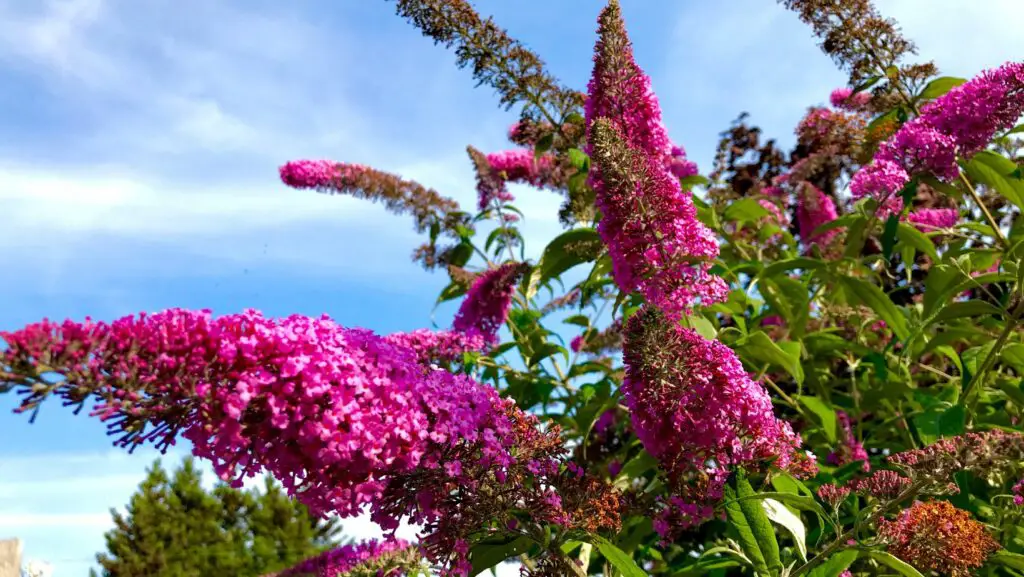
Buddleias have two major assets: their great simplicity of culture – they are thus advised to the beginners – and their splendid summer bloom in large ears which comes to which wakes up the flowerbeds.
Butterflies are not mistaken, by the way.
In this article, I have gathered for you all the information about this plant, its main characteristics and what you need to know to plant and grow it.
Characteristics of the buddleia plant
| Scientific name | Buddleia spp. |
| Family | Buddleiaceae |
| Origin | China |
| Foliage | Deciduous |
| Flowering | June-September |
| Rusticity | -15°C (-59°F) |
| Exposure | Sun |
| Soil | Indifferent |
Buddleias are medium-sized shrubs (2.50 to 3 m), branched and spreading, fast growing.
Some are dwarf, or announced as such, and of smaller size. The bloom is presented in big spikes from 15 to 30 cm, with shimmering colors.
Very fragrant and melliferous, they attract insects and butterflies.
How to grow a butterfly bush
Buddleias can grow in any type of soil, even poor, but well-drained, as they do not like stagnant water. Remember to lighten heavy soils with gravel (1/4) and let the soil dry out well between waterings. In early spring (March), prune all summer shoots that have bloomed to within 5 cm of their start.
Remove dead wood and branches directed toward the center of the crown.
Remove deadheading as you go along. Respect the full sun exposure.
How to grow a butterfly bush in a pot
Growing a butterfly bush in a pot is a great way to enjoy the beauty of this vibrant flowering shrub without taking up too much space. Dwarf varieties are ideal for pots, as they do not grow too tall and can be easily managed (Use a pot of 30 to 40 cm of diameter at least). The soil should be well drained, and the pot should be large enough to accommodate the roots. Place the pot in a sunny spot, preferably sheltered from strong winds, and water regularly. Fertilize with a balanced fertilizer once a month during the growing season. Prune in late winter or early spring to maintain the desired shape. With proper care and attention, your butterfly bush will produce an abundance of colorful blooms throughout the summer.
Where to plant a butterfly bush
Take advantage of the speed of growth of buddleias for the creation of new beds and compound hedges. For a fast result, you can plant every meter but the ideal is to respect a spacing of 1,50m between two feet.
A buddleia trained and maintained in a goblet can then be planted in isolation.
These shrubs are self-sufficient; however, think of associating several varieties with complementary tones.
Our selection
Most of the buddleias offered are from Buddleia davidi. One of the most remarkable is ‘Black Night‘ with its long, dark purple, almost black spikes. ‘Empire Blue‘, blue-purple, ‘Royal Red‘ with bright red-purple inflorescences, ‘Pink Delight‘, deep pink, and ‘Charming‘, lavender blue, give a glimpse of the diversity of tones.
‘White Profusion‘ is recommended for those who like pure white.
Among the varieties with variegated foliage, consider ‘Santana‘, spotted with yellow and with red flowers, and ‘Harlequin‘, with creamy white borders and cardinal red spikes.
Beware of the “dwarfs” with small leaves: they are in fact varieties with compact vegetation but which grow in height and exceed 1,50 m. Remember ‘Nanho Blue‘, purplish blue, and
‘Nanho Purple‘, dark purple.
On the other hand, ‘Purple Emperor‘, purplish flowering, rarely exceeds 1 m in all directions. It is recommended for cultivation in pots or containers.
Read the labels carefully as some buddleias produce short, globular spikes, such as B. x weyeriana ‘Golden Glow’, yellow-orange, and ‘Sungold‘, orange.
As for B. globosa, it is more of a botanical curiosity with its small inflorescences in perfectly round orange glomerules.
In a nutshell
Buddleia plants are incredibly versatile as you can see from this article. From their easy maintenance to the great pollinator benefits they offer, Buddleia plants make for a great addition to any garden.
Whether you’re looking to introduce a few butterfly magnets or just want some low-maintenance greenery – Buddleia might just be a perfect choice.

Hi!
I am the guy behind Theyardable.com. I grew up on a homestead and I am here to share the knowledge I have and things I learn while living in the countryside.
